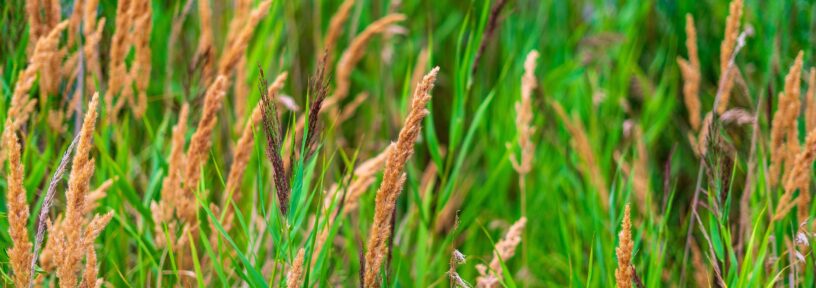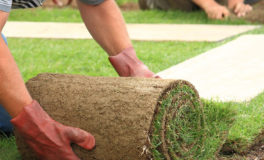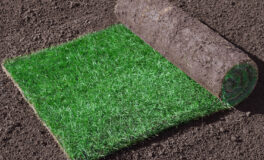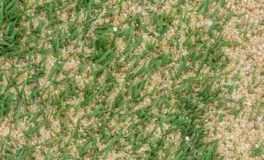Grass Species – This article contains a list of all the grass species that are contained in our Turf and Wildflower Turf products.
Table of Contents (click each heading for further information on each grass species)
Brown Top Bent (Agrostis capillaris)
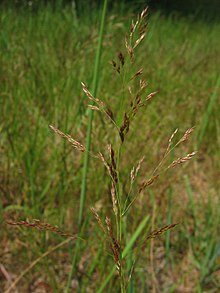
Brown Top Bent in Meadowmat:
Brown Top Bent (or Common Bent or Colonial Bent) is the ideal grass to enhance the flowering plants in Cottage Garden Meadowmat. It’s root system makes the matting easy to harvest, transport and install. Once established those flower heads are just gorgeous. But most importantly, this delicate grass won’t out-compete or swamp the flowers growing around it. Naturally, it is a key species for large areas of permanent grassland, particularly on poorer soils, frequently found on hills and mountains. It is also common on lowland pasture, heaths, hay meadows, and in open areas of plantations, woodland and scrub, although the continued loss of permanent pasture means it is less common than it once was.
In Species Rich Meadowmat, we love Brown Top Bent because its slow growing and happy to be mown every couple of weeks or so.
There’s another reason for liking it too – the seed is readily available and helps to keep costs as low as possible without compromising the appearance of the final product.
Key facts about Brown Top Bent
- Grows anywhere between 15cm and 80cm
- Likes poorer soils
- Produces short rhizomes
Chewings Fescue (Festuca rubra subsp. commutata)
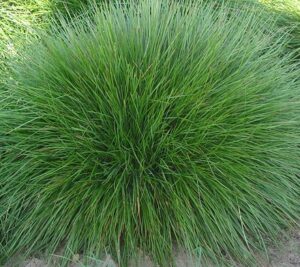
You will most likely find Chewings Fescue on golf greens, tees and fairways because of its high shoot density and tolerance to close cutting. It maintains its lush green colour throughout the year. In order to get the best out of Chewings Fescue it will need well-drained soil. Commonly used and well-established as grass for pasture areas Chewings Fescue is also common on grass verges, roadsides and in sports applications. Its a favourite for home lawn use because of its drought and shade tolerance.
Key facts about Chewings Fescue
- Grows anywhere between 15cm and 80cm
- Prefers to grow in shady, cooler areas
- Requires minimal water and fertiliser
- Shade tolerant
- Drought tolerant
- Will tolerate close-mowing
Creeping Bent (Agrostis stolonifera)
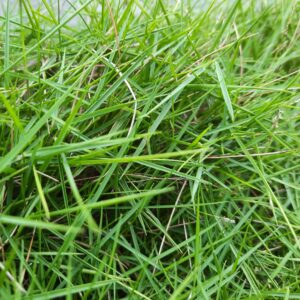
Creeping Bent is a fast-growing perennial grass that spreads by surface rooting stolons to form a mat or thatch layer above the soil line. It will usually make its way onto your lawn from birds flying over and dropping a seed. If you examine the Creeping Bent you will see it has lots of stems that extend along the surface of the soil.
Creeping Bent is a perennial grass normally found in damp arable fields and grassland. It likes gardens, rough ground and ditches – almost anywhere by water. It can be found on all soils but its preferred soil types are chalk and gravel soils. It is less common on clays. Poorly-drained acid or alkali soils are preferred with a medium to heavy texture. Consequently, Creeping Bent is common throughout Britain.
To get rid of Creeping Bent you will need to use Herbicides like Roundup and then reseed the dead patches at a later date.
Key facts about Creeping Bent
- Grows between 20 and 50 cm in height, possibly taller on fertile soils.
- Flowers June – July
Crested Dogstail (Cynosurus cristatus)
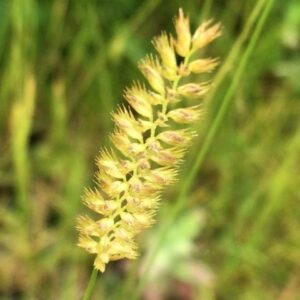
Crested Dogstail is a commonly-harvested perennial grass found in many grasslands and meadows across the country. Crested Dogstail works beautifully as part of any Meadowmat mix and has delicate violet flowers which flower during the summer. It’s a particular favourite as it attracts butterflies, acting as a good source of food for many species of Lepidoptera. It will also give a good green coverage throughout the winter, withstanding cold temperatures and winds.
Crested Dogstail is traditionally a perennial, grazing grass, common in pastures as it helps to fill out the base of the sward. Thankfully, it is not particularly aggressive and enjoys a long growing season . During the off-season it will maintain its colour but it will produce wiry stems if not cut or grazed. Look for it in sheep pastures and traditional grazing and because of its non-aggressive nature it can often be found within grasses and wildflower mixes.
Regular cutting or mowing for hay will will help it as it does not cope well with aggressive, tall swards and heavy shading.
The leafy lower growing leaves are acceptable to livestock, especially sheep. It will withstand cold conditions and dry periods, with the ability to stay green long into the winter.
Key facts about Crested Dogstail
- 5–75 cm tall
- The leaf blades are narrow, fine and pointed.
- When to see? January to December
- Good cold tolerance
- Likes regular mowing
Hard Fescue (Festuca brevipila)
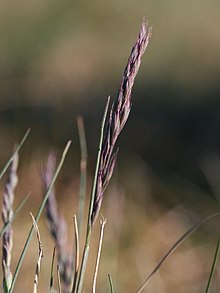
Hard Fescue is low maintenance. Hard Fescue is often not mowed and can be left un-mowed (it doesn’t respond well to close mowing). Often used in grass seed mixtures where shade will be a problem.
Hard Fescue has a very fine-bladed, greyish to dark-green grass. The leaves are folded in the bud, there are no auricles, and a membranous ligule is present.
Hard fescue is a low-growing perennial turf grass that is considered to be one of the best species to use in low-maintenance areas. The species is resilient to the sort of environmental conditions found on verges so it can cope with drought, salinity, low fertility, and cold. It will successfully compete against weeds and it is both widely available in the UK, and commonly used as it really only needs mowing about twice a year in late spring and autumn.
Key facts about Hard Fescue
- Height: 15cm – 70cm
- Flowers: May – Aug
- Leaves are a greyish-green to bluish-green colour
- An extremely fine-leaved, densely-tufted perennial plant (non-rhizomatous)
- Commonly found in lawns, meadows, road verges, banks, parks, sports clubs and any other free draining or sandy land
- Does well on low fertility soils and in shaded areas.
Meadow Barley (Hordeum brachyantherum)
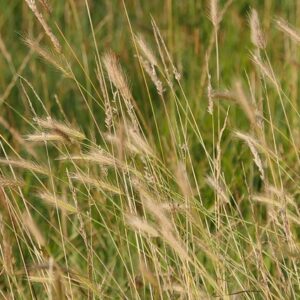
Meadow Barley is a perennial grass that grows in meadows, pastures and roadsides. It can be identified with its tight seed flower heads which have long awns, much like normal barley. The flat leaves do not stand out from the rest of the grass species, making this difficult to identify until its flowered. The good news is that Meadow Barley seed can be sown at any time of the year so long as soil conditions are suitable. It normally only forms a minor component of grassland communities and so is usually only added in small amounts to add interest and diversity to meadow mixtures for damp soils.
Key facts about Meadow Barley
- 30 – 60cm tall with narrow flat roughish leaves.
- Flowers June – July
- Habitat: Likes damp soil. Especially old meadows, floodplains and coastal grassland
Perennial Ryegrass (Lolium perenne)
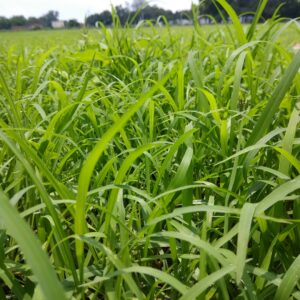
At Turfonline we use Perennial Ryegrass for durability, a rich green colour and disease resistance.
Perennial Ryegrass can be found in most grass seed mixes and is the most widely sown grass species. It will establish quickly and respond well to fertiliser; it reacts well to cutting and grazing.
Perennial Ryegrasses are used for turf and high-quality livestock pasture grasses. Despite its agricultural uses, Perennial Ryegrass is no relation to the cereal grain. It is , however, related to Annual Ryegrass. Like many common turf grasses, Perennial Ryegrass is native to Europe. It likes moderate summers and cool winters.
Did you know?
It can even be made into silage, hay or haylage.
Key facts about Perennial Ryegrass
- Grass from the family Poaceae
- Perennial Ryegrass does not spread naturally because it does not produce rhizomes or stolons
- Perennial Ryegrass grows most vigorously during the cool months and spring seasons
- Perennial Ryegrass is most easily identified by the red base to its tillers and the shiny underside to its leaves.
POA Supina
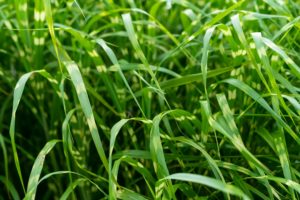
It’s perfect for repairing bare patches in Shadesman+ lawns. Shadesman+ Seed will create a lawn with unmatched shade tolerance and will also blend in perfectly with your existing Shadesman+ turf. Shadesman+ Seed is especially beneficial if turfing in an area shaded by trees. The seed encourages and maintains healthy growth for new and existing turf that isn’t receiving the necessary TLC.
Due to its slow growing nature, this seed is best sown between March and September when temperatures are a little warmer.
Our original Shadesman seed contained 100% supernova POA Supina Seeds whereas our new Shadesman plus is a mix of 50% Supernova POA Supina Seed and 50% POA Pratensis seed. By adding an additional species, we have improved the drought and shade tolerance, whilst also improving the year-round colour of the previous mix.
Key facts about POA Supina
- Can tolerate up to 90% shade
- Spreads aggressively
- It can be mown very short
Quaking Grass (Briza)
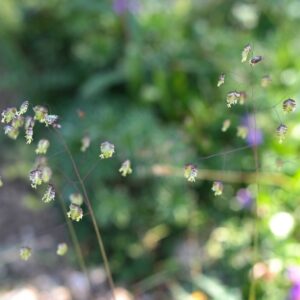
Also known as Cow-Quake, Jiggle-Joggles and Tottergrass, Quaking Grass is not toxic. It is a pretty grass with delicate fronds that dance in the breeze. We like it because it’s not in the least bit invasive and won’t outcompete wildflowers growing alongside it. Rather, the flower heads complement the plants around it and add a whole extra layer of interest to a garden. Quaking Grass is a short-lived perennial although it can take a while to establish. Its neutral colouring makes it the perfect foil for more colourful flowers, so is best grown in groups where it can provide contrast and backdrop. It prefers moist but well-drained soils in full sun to partial shade.
Key facts about Quaking Grass
- Height: 10-40cm
- Flower heads are delicate with little spikelets that look like drops of water. Each spikelet is 4-5mm long.
- Flowering Time: June – August
- Flower colour: purple tinged green ripening to light brown
- Growth habit: Perennial grass with creeping roots
- Habitat: Found almost everywhere in the UK with the exception of the far southwest of England and the north-western region of Scotland. Loves unimproved species rich grass land on chalky soils.
Rough Stalked Meadowgrass (Poa trivialis)
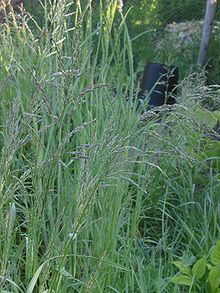
Rough-Stalked Meadowgrass occurs as both an annual and perennial grass with procumbent tillers some of which become leafy stolons. It also has flat or folded leaves which are generally low to the ground and often mixed at the base of other grasses. In fertile soils it can be quite competitive during establishment, and will smother weeds and slower growing wild flower seedlings. So stick to poor soils when using with wildflower turf and mixes.
Its flowering stems are slightly rough to touch and can rise up to 60cm with branched heads; these are green and closed in moist conditions, open and tinged red in dry conditions.
Key facts about Rough Stalked Meadowgrass
- Height: 30-100cm
- Can be sown at any time of year dependent on conditions
- Rapid germination
- Avoid planting on good soil
Sheep’s Fescue (Festuca ovina)
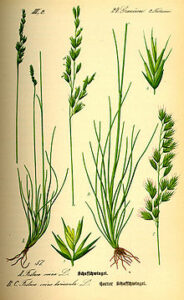
Sheep’s Fescue is a perennial plant that is easily recognisable for its green/grey, short bristly leaves. With its tall thin stems displaying several separate tufts or florets that turn to seeds that remain on the stem throughout much of the summer, being scattered by the wind in autumn.
Using Sheep’s Fescue in Your Garden
Turfonline pre-seed their rolls of Wildflower/ Meadowmat turf with a carefully-balanced mix of wildflowers and grasses to achieve this, making it easier than ever to grow a great patch of meadow that includes species like Sheep’s Fescue. In recent times intensive farming has greatly reduced the availability of flora to the UK’s fauna, Meadowmat is a great way to help to redress this and promote greater natural pollination.
Key facts about Sheep’s Fescue
- Scientific name is Festuca Ovina
- Flowers in mid-spring (May to June)
- Hardy
- Drought tolerant
- Withstands grazing and close-mowing
- Grows in clumps or tufts and is very commonly found on wasteland, grasslands and moors.
Slender Creeping Red Fescue (Festuca rubra litoralis)
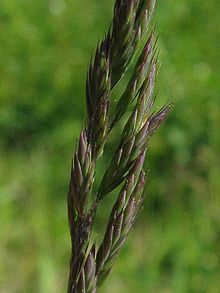
It tends to prefer shady, cooler areas. It is often used in mixtures with Tall Fescue, as well as Bluegrass and Perennial Ryegrass. Creeping Red Fescue is known for its ability to establish a lawn quickly, as well as the ease with which it can be maintained because of its non-aggressive nature.
Also known as Strong Red Fescue due to its hardy nature, Creeping Red Fescue is ideal for use as an ornamental grass in its own right, or as a buffer to help protect other meadow-dwelling flowers like bluebells or croci – making it perfect for use within Meadowmat. It’s bright, deep hues generally work well with flowering plants in pastel or vibrant shades, and it is an excellent all-rounder when it comes to preparing or designing a meadow or garden area.
- Cool season grass
- Plant in Autumn or Spring
- Prefers shady, cooler areas
- Can be allowed to grow throughout the season
Small-leaved Timothy (Phleum bertolonii)
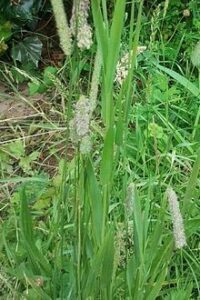

Small-leaved Timothy is found throughout the United Kingdom. It is a leafy perennial grass species that likes lowlands and foothills. It is often found in old pastures and hedgerows . It is easily digested by cattle and produces good quality hay. It will succeed on damp, wet and heavy soils although it can also tolerate lighter soils. Normally thought of as a smaller, lower yielding relative of Timothy.
Key facts about Small Leaved Timothy
- 10-50cm in height
- Flowers June – Aug
- Habitat: pasture, grasslands, meadows and roadsides
- Scientific name: Phleum bertolonii
- Family: Poaceae
- Small Leaved Timothy is a perennial species found throughout the UK.
Smooth Meadow Grass (POA Pratensis)


Smooth-stalked Meadowgrass is frequently found in the wild in both mineral and humus rich soils in both the northern and southern hemispheres. It is a fine-leaved, persistent species with erect, leafy shoots.
Growth starts early in spring and re-growth consists mainly of leafy material, which can be mown very easily and cleanly.
It tolerates hard wear and can regenerate from a vigorous, side-tillering rhizome root system, even if the sward is badly damaged. These features make it fantastic for golf tees, sports surfaces or lawns.
Germination and establishment are slower than most grass species and slow to establish in the sward but once mature it forms a strong presence within the mix (providing it is sown in the correct ratio).
This grass species is drought tolerant and winter hardy which makes it a perfect partner for Jubilee Turf.
Smooth stalked meadow grass also has excellent shade tolerance and winter greenness. It has a flowery seed head which is easily confused with annual meadow grass and as they are from the same family this is an easy mistake to make. Annual meadow grass is, however, a weed grass which to the trained eye has obvious differences.
The easiest way to tell the difference if not the seed head, it is the leaves. The annual meadow grass leaf has a crinkle to the leaves which differentiates it from the smooth stalked meadow grass.
Why Smooth-stalked Meadowgrass is used in lawn turf
Smooth stalked meadow grass adds rapid recovery from wear, shade tolerance and rich colour.
Key facts about Smooth Meadowgrass
- Very Hard Wearing
- Creates a very dense turf
- Tolerant to dry and hot conditions as well as very cold conditions
- Requires warmer temperatures to germinate
- Slow to establish
Strong Creeping Red Fescue (Festuca rubra)



At Turfonline we use Strong Creeping Red Fescue for a soft, velvety texture.
Strong Creeping Red is commonly used on Golf greens/fairways, bowling greens but you will also see it on general lawn. The Strong Creeping Red growth habit of strong creeping red fescue makes it ideal for use on steep embankments where it is important to stabilise the soil and prevent erosion.
Key facts Strong Creeping Red Fescue
- Sow between April and early October.
- Fine, needle-like leaves
- Tolerant of dry soil conditions
- Slow growing
- Creeping growth habit
Tall Fescue (Festuca Arundinacea)
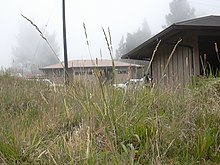

A tall fescue with broad and course leaves. It grows mainly in clumps and has very long roots that allow it to access moisture deep into the soil, making it more drought tolerant than other grass species. Although it grows best in moist environments, Tall Fescue has good drought tolerance and will survive during dry periods in a dormant state. Tall Fescue is adapted to a wide range of soils, but does best on clay soils high in organic matter.
This grass variety doesn’t need frequent mowing, which is a chore most of us could do without. The good news is that Tall Fescue won’t overtake other grasses so it’s a good choice for mixes.
Key facts about Tall Fescue
- Height: 60-200cm
- Very hardy and drought tolerant
- Low risk to disease
- Soil Tolerant
- Prefers clay spoils
Tufted Hair Grass (Deschampsia cespitosa)
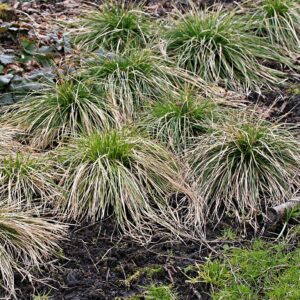

Perfect choice if you want to add height and structure to a garden, Tufted hair enjoy full sun but also partial shade it thrives when in moist and organically rich soils. Tufted Hair Grass will flourish in sun or light shade in reliably moist soils, and it will become tolerant of drought once it has had a chance to become established. It is characterised by neat mounds of dark green leaves with masses of flowers during the summer months. The mounds and tuft will usually grow to between two and four feet high with a spread of between one and two feet.
Key facts about Tufted hair grass
- Up to 120 cm tall
- Leaves to 5mm wide
- When to see? June to August.
- Very common throughout Britain.
- Plant in the spring
- Likes sun to light shade
Yellow Oatgrass (Trisetum flavescens)
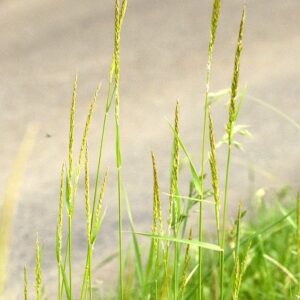

Yellow Oat-grass have loose spreading flowerheads with shiny yellow spikelet’s (Sometimes tinged purple). Yellow Oat-grass can be found in hay meadows and lowland pasture, or on banks and verges. It is found most frequently on well-drained neutral and chalky soils. Most commonly found in lightly-grazed hay meadows it is quite drought resistant and can easily colonise bare ground from seed after summer drought. Yellow Oat-grass can be sown at any time of the year when soil conditions are suitable. It has fine seeds and is usually included in seed mixtures in small amounts sufficient to contribute to the interest, diversity and balance of sown meadows and grassland. Good meadow management will help maintain its presence in a sward. Whilst it is a nice grass to cut with a scythe it will only deliver moderate yields so has fallen out of favour with modern farming.
Key facts about Yellow Oatgrass
- Height: 30-60cm.
- Flowers: June and July
- Likes well drained soils
